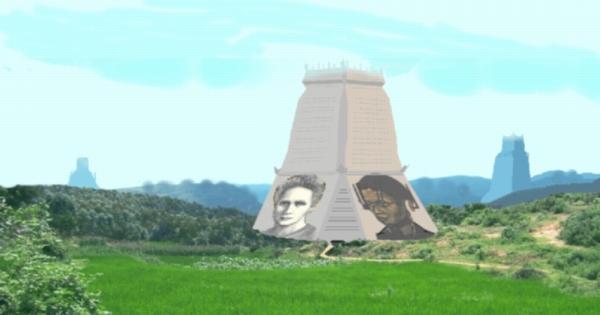BY LETTER
Heisenberg City, Corona
 Image from Steve Bowers | |
| Heisenberg arcologies in surrounding parkland; images of Marie Curie and Ruth Duorkin are displayed | |
Heisenberg is one of the largest habitation nodes on Corona and in many ways reflects the cosmopolitan nature of that ancient world. The city is home to over a hundred million sophonts made up of a wide variety of races and clades, and this diverse population is reflected in the metroplex's structure.
Beginning on the northernmost tip of the Bay and extending eastward along the northern shore, the heart of the city is some two dozen arcology towers. Ranging from one to three kilometers in height, each is separated by a distance of about ten kilometers and is backed by a mix of parkland and thick forest extending away from the shore into the continental interior. The tower districts are home to a diverse population of near-baselines, su, provolve, vec, and sophtware based intelligences and are connected by a network of vac-trains, aircars, and high-bandwidth lynk stations.
Each tower also features large expanses of unbroken wall surface that is covered in smart matter which is used to form the cities famous 'regression frescoes'. Each smart matter section (some of which extend the entire height of the tower) is programmed to mimic the look and feel of various types of stone (marble, sandstone, and various types of granite are most popular) and is then shaped into great bas relief panels depicting scenes from the great moments of Terragens history (often relating to science).
However, the artistry of the frescoes does not end at the large scale images that grace each tower and that can be seen from kilometers away. Each fresco is made up of smaller carvings, which in turn are made up of still smaller carvings, and so on. At each level the viewer finds a new level of detail and discovers that the story or event depicted at the larger scale is perhaps only a chapter in the greater story being represented at the scale below. It is not uncommon for Heisenberg regression frescoes to span a hundred levels or more, with the smallest features extending into the micron scale and requiring specialized synsect mounted sensors to be properly viewed and appreciated.
As the smart matter making up the frescoes is gradually reprogrammed the images displayed will slowly change at one level or another. On occasion, an image will call for the presence of water or living plant-life to be properly displayed and the requisite materials will be provided. Nanotechnic support systems allow extensive soil and plant systems to cling to the side of the towers and water pumped up from the Bay or condensed from the air is used to form various fountains, waterfalls, and reflecting water features along the vertical face of the building.
The forest extending inland from the Heisenberg tower districts is itself actually another district of the city and represents an example of the Coronan mastery of genetic technology. Much of the forest is actually made up of 'treehouses', engineered trees that have been designed to grow into large and comfortable homes for their inhabitants including all the amenities of any home such as food, water, lighting and heat, and access to the Coronan system data networks. Although no part of Heisenberg can be said to be exclusively home to one race or another, the arboreal districts mostly provide living space for a mix of near-baselines, Superiors, primate provolves, and other species who trace their origins back to forest living life forms.
The culmination of the forest districts is actually found at their far end where several Motherwood trees have been planted in recent centuries. They support an extensive Shepbra population living in their traditional homes as well as large primate, avian, and arboreal or would be arboreal populations.
Extending from the arcology towers in the other direction (and into the waters of Feynman Bay) are large piers or causeways, each a direct extension of the city tower and just as fully inhabited. Each pier terminates several kilometers out in the Bay at a large floating habitation complex which then projects further extensions out to the neighboring complexes and pier structures. Each floating district extends both across and below the water and is home to a wide variety of aquatic, semi-aquatic, and amphibious clades including merpeople, provolved cetaceans, Brain Kelp, Iniliak, submersible based vecs, and others.
Overlaying and interpenetrating the entire Heisenberg metropolitan area is a large and developed cybercosm, hosting nearly 30 million upload, ai and virtual sophonts. Local computing nodes vary in structure from district to district with a large percentage employing syntech based processors that combine the best features of biological and drytech based systems to produce the optimum environment for the resident sophtware.
Although not the largest metropolitan area in the Corona system, Heisenberg is generally agreed to be one of the most diverse and interesting.
Related Articles
Appears in Topics
Development Notes
Text by Todd Drashner
Initially published on 15 May 2007.
Initially published on 15 May 2007.






